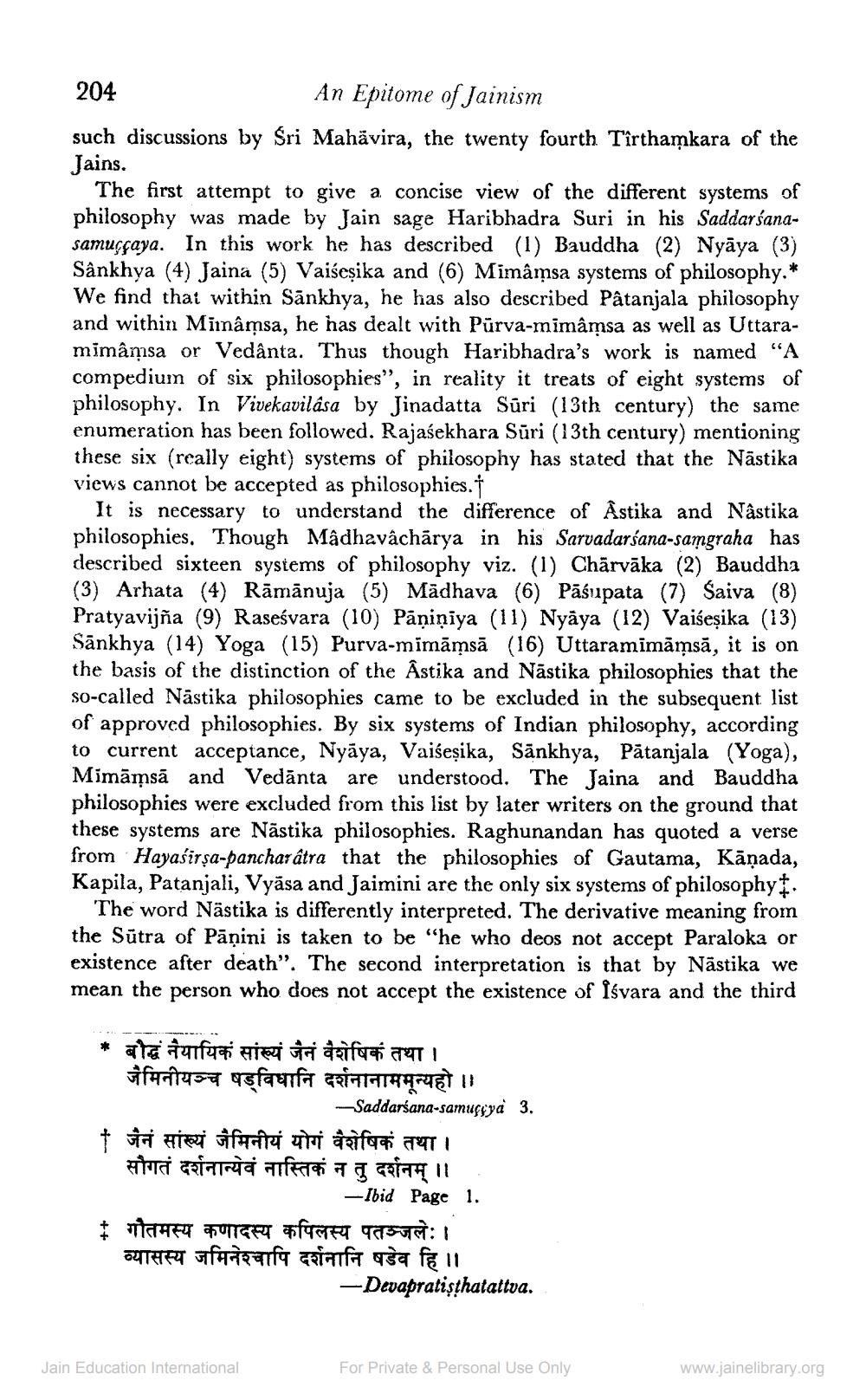________________
204
An Epitome of Jainism such discussions by Sri Mahavira, the twenty fourth Tîrthamkara of the
Jains.
The first attempt to give a concise view of the different systems of philosophy was made by Jain sage Haribhadra Suri in his Saddarśanasamuççaya. In this work he has described (1) Bauddha (2) Nyāya (3) Sânkhya (4) Jaina (5) Vaiseșika and (6) Mimâmsa systems of philosophy. * We find that within Sānkhya, he has also described Patanjala philosophy and within Minâmsa, he has dealt with Pūrva-mimâmsa as well as Uttaramimâmsa or Vedânta. Thus though Haribhadra's work is named "A compedium of six philosophies”, in reality it treats of eight systems of philosophy. In Vivekavilása by Jinadatta Sūri (13th century) the same enumeration has been followed. Rajasekhara Sūri (13th century) mentioning these six (really eight) systems of philosophy has stated that the Nāstika views cannot be accepted as philosophies.
It is necessary to understand the difference of Åstika and Nâstika philosophies. Though Madhavâchārya in his Sarvadarśana-samgraha has described sixteen sysiems of philosophy viz. (1) Chārvāka (2) Bauddha (3) Arhata (4) Rāmānuja (5) Madhava (6) Pāśupata (7) Saiva (8) Pratyavijña (9) Raseśvara (10) Pāņiņiya (11) Nyāya (12) Vaiseșika (13) Sānkhya (14) Yoga (15) Purva-mimāmsā (16) Ut
5) Uttaramimāmsā, it is on the basis of the distinction of the Âstika and Nästika philosophies that the so-called Nāstika philosophies came to be excluded in the subsequent list of approved philosophies. By six systems of Indian philosophy, according to current acceptance, Nyāya, Vaišeşika, Sānkhya, Patanjala (Yoga), Mimāmsā and Vedānta are understood. The Jaina and Bauddha philosophies were excluded from this list by later writers on the ground that these systems are Nāstika philosophies. Raghunandan has quoted a verse from Hayasirşa-pancharâtra that the philosophies of Gautama, Kāņada, Kapila, Patanjali, Vyāsa and Jaimini are the only six systems of philosophy I.
The word Nästika is differently interpreted. The derivative meaning from the Sūtra of Pāṇini is taken to be "he who deos not accept Paraloka or existence after death”. The second interpretation is that by Nāstika we mean the person who does not accept the existence of Isvara and the third
* ale tufua Hiet diferhati जैमिनीयञ्च षड्विधानि दर्शनानाममून्यहो ।
Saddarśana-samuçsya 3. + जैनं सांख्यं जैमिनीयं योगं वैशेषिकं तथा। सौगतं दर्शनान्येवं नास्तिकं न तु दर्शनम् ।।।
-Ibid Page 1 * गौतमस्य कणादस्य कपिलस्य पतञ्जलेः। व्यासस्य जमिनेश्चापि दर्शनानि षडेव हि ।।
-Devapratișthatattva.
Jain Education International
For Private & Personal Use Only
www.jainelibrary.org




